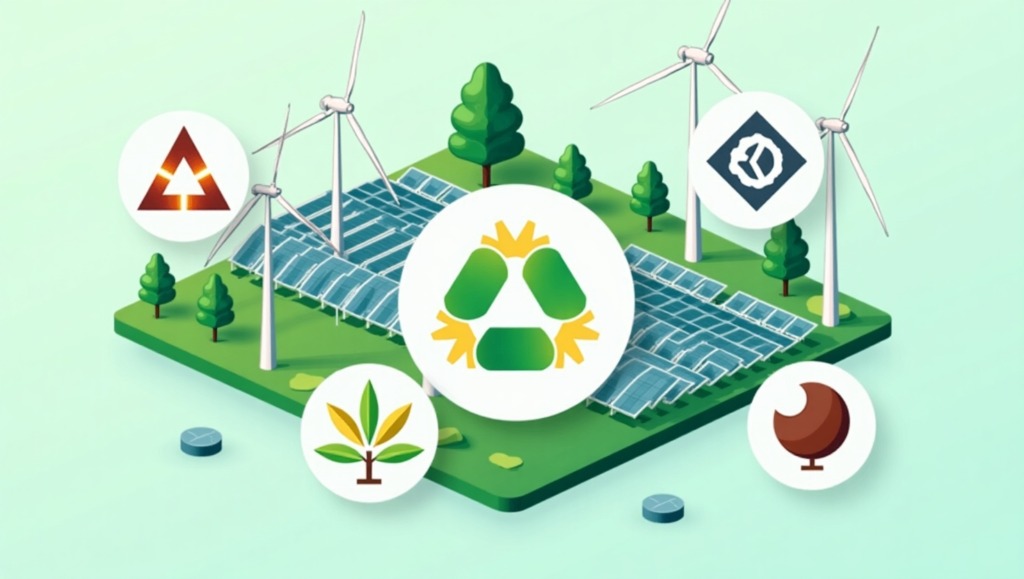The Rise of Green Crypto in 2025

The rapid growth of cryptocurrency has revolutionized finance, but it has also raised urgent environmental concerns. Traditional blockchain networks, particularly those using Proof of Work (PoW) consensus mechanisms like Bitcoin, consume vast amounts of electricity—often sourced from fossil fuels. In recent years, the crypto industry has faced mounting criticism for its carbon footprint, prompting a global push toward sustainability.
By 2025, the narrative has shifted dramatically. The rise of green crypto—environmentally friendly digital currencies and sustainable blockchain solutions—has become a top priority for developers, investors, and regulators. With climate change accelerating, the demand for energy-efficient alternatives to PoW has never been higher. Innovations such as Proof of Stake (PoS), carbon-neutral mining, and blockchain-based carbon offset programs are leading the charge toward a more sustainable future.
Ethereum’s landmark transition from PoW to PoS in 2022 (known as “The Merge”) set a powerful precedent, reducing its energy consumption by over 99%. Since then, newer blockchains like Algorand and Cardano have emerged as leaders in low-impact crypto, while legacy projects explore renewable energy solutions. Beyond just reducing harm, blockchain technology is now being leveraged to actively support environmental causes, from transparent carbon credit trading to tracking sustainable supply chains.
This article explores the latest advancements in eco-friendly cryptocurrencies and sustainable blockchain technology in 2025. We’ll analyze the environmental impact of different consensus mechanisms, highlight the most energy-efficient cryptocurrencies, examine Ethereum’s post-Merge benefits, and showcase how blockchain is being used to fight climate change. Finally, we’ll look ahead at the future of green crypto—where sustainability and decentralization go hand in hand.
Environmental Impact of Proof of Work (PoW) vs. Proof of Stake (PoS)

The Energy Dilemma of Proof of Work (PoW)
Proof of Work (PoW) has long been the backbone of major cryptocurrencies like Bitcoin and (pre-2022) Ethereum. However, its environmental cost is staggering. PoW relies on competitive mining, where miners solve complex cryptographic puzzles to validate transactions and secure the network. This process demands massive computational power, leading to exorbitant energy consumption.
- Bitcoin’s Energy Footprint: As of 2025, Bitcoin’s annual energy consumption is estimated at 120+ TWh—comparable to the electricity usage of entire countries like Argentina or Norway.
- Carbon Emissions: Depending on the energy mix (coal vs. renewables), Bitcoin mining emits 40-60 million tons of CO₂ annually, raising concerns about its long-term sustainability.
- E-Waste Concerns: Mining hardware becomes obsolete quickly, generating thousands of tons of electronic waste yearly.
How Proof of Stake (PoS) Solves the Energy Crisis
Proof of Stake (PoS) emerged as a game-changing alternative, eliminating energy-intensive mining. Instead of competing computationally, PoS validators are chosen based on the amount of cryptocurrency they stake (lock up as collateral).
- Energy Efficiency: PoS blockchains like Cardano and Solana use 99.9% less energy than PoW networks.
- Decentralization & Security: Critics initially questioned PoS’s security, but modern implementations (e.g., Ethereum’s Casper FFG) ensure robust protection without wasteful computations.
- Scalability Benefits: PoS enables faster transactions and lower fees, making it ideal for mass adoption.
Comparative Analysis: PoW vs. PoS in 2025
| Factor | Proof of Work (PoW) | Proof of Stake (PoS) |
| Energy Consumption | Extremely High (1000+ kWh/tx) | Minimal (~0.01 kWh/tx) |
| Carbon Footprint | High (Tons of CO₂ per tx) | Near-Zero |
| Hardware Waste | Significant (ASIC miners) | Minimal (No mining rigs) |
| Security Model | Hash Power = Security | Economic Stakes = Security |
With climate regulations tightening, PoW’s dominance is fading, while PoS and hybrid models gain traction.
Carbon-Neutral and Energy-Efficient Cryptocurrencies in 2025

Leading Green Cryptocurrencies
Several blockchain projects have prioritized sustainability, leveraging PoS, renewable energy, and carbon offsets to minimize environmental harm.
1. Ethereum (ETH) – The Post-Merge Pioneer
After transitioning to PoS in 2022, Ethereum reduced its energy use by ~99.95%, setting a benchmark for large-scale blockchains.
- Current Energy Use: ~0.0026 TWh/yr (vs. ~110 TWh/yr pre-Merge).
- Future Upgrades: Proto-danksharding (EIP-4844) further optimizes efficiency.
2. Algorand (ALGO) – The Pure PoS Leader
Algorand uses a Pure Proof of Stake (PPoS) mechanism, ensuring decentralization while maintaining ultra-low energy costs.
- Carbon-Neutral Since 2021: Partners with ClimateTrade to offset emissions.
- Energy Per Transaction: ~0.000008 kWh (negligible compared to Bitcoin’s ~1,100 kWh).
3. Cardano (ADA) – Peer-Reviewed Sustainability
Cardano’s Ouroboros PoS is academically designed for efficiency and security.
- Energy Use: ~0.5479 kWh per transaction (far below PoW chains).
- Real-World Use Cases: Used in green agriculture and supply chain tracking.
4. Solana (SOL) – High Throughput, Low Carbon
Despite past outages, Solana remains one of the most energy-efficient high-speed blockchains.
- Energy Per Transaction: ~0.0006 kWh.
- Carbon Neutral Goals: Actively investing in renewable energy credits.
Renewable Energy Mining Initiatives
Even PoW chains are adopting greener practices:
- Bitcoin Mining Councils: Over 58% of Bitcoin mining now uses sustainable energy (hydro, solar, wind).
- El Salvador’s Volcano-Powered Mining: Geothermal energy powers state-backed Bitcoin mining.
The Role of Carbon-Negative Blockchains
Some projects go beyond neutrality to actively remove CO₂:
- Chia (XCH): Uses Proof of Space & Time (hard drive-based, lower energy).
- Hedera (HBAR): Claims negative carbon footprint via optimized consensus.
Ethereum’s Transition to PoS and Its Environmental Impact

The Merge: A Turning Point for Crypto Sustainability
Ethereum’s shift from PoW to PoS (completed Sept. 2022) was one of the most significant events in blockchain history.
Key Changes Post-Merge:
- Elimination of Mining: No more GPU/ASIC farms competing for blocks.
- Energy Reduction: Dropped from ~78 TWh/yr to ~0.01 TWh/yr—equivalent to removing 5 million cars from roads.
- Staking Rewards: Validators now earn ETH by staking, not burning electricity.
Challenges & Criticisms
- Centralization Concerns: Large staking pools (e.g., Lido, Coinbase) hold significant influence.
- Liquid Staking Risks: Platforms like Lido introduce smart contract vulnerabilities.
Ethereum’s Long-Term Sustainability Roadmap
- Danksharding (2025-26): Will further cut energy needs via data efficiency upgrades.
- Layer 2 Scaling: Rollups (Arbitrum, Optimism) reduce mainnet load, enhancing sustainability.
Broader Industry Impact
Ethereum’s success has pressured other PoW chains (e.g., Bitcoin, Litecoin) to explore hybrid models or PoS alternatives.
Blockchain Solutions for Environmental Causes

Tokenized Carbon Credits: Bringing Transparency to Offsets
One of the most impactful green blockchain applications is the tokenization of carbon credits, solving long-standing issues of fraud and inefficiency in traditional carbon markets.
- KlimaDAO – This decentralized organization backs its KLIMA token with real carbon offsets, creating a liquid market for carbon trading. By Q2 2025, over 20 million tons of CO₂ have been retired on-chain.
- Toucan Protocol – A bridge between traditional carbon markets and DeFi, allowing credits to be tokenized as Base Carbon Tonnes (BCT). Major corporations now use Toucan to automate ESG compliance.
- Flowcarbon – A blockchain-based carbon registry that ensures credits aren’t double-counted, using smart contracts for verification.
Sustainable Supply Chains: From Farm to Blockchain
Blockchain’s immutability makes it ideal for tracking ethical sourcing:
- IBM Food Trust – Used by Walmart and Nestlé to trace food origins, reducing fraud and waste.
- Provenance (XRP Ledger) – Tracks fair-trade products, ensuring no deforestation or forced labor in supply chains.
- Plastic Bank – A Solana-based project rewarding plastic waste collection with crypto, preventing ocean pollution.
Wildlife Conservation & Reforestation Tracking
- WWF’s Panda Conservation Tokens – NFTs fund anti-poaching efforts, with blockchain verifying fund allocation.
- Treejer – A Polygon-based dApp that plants trees and records growth via satellite + IoT sensors.
- OceanDAO – Funds marine cleanup initiatives, with transparent spending logs on-chain.
Challenges & Future Outlook
While promising, blockchain environmental solutions face hurdles:
- Data Oracles – Reliable real-world data feeds remain a bottleneck.
- Regulatory Uncertainty – Governments are still defining rules for tokenized assets like carbon credits.
- Scalability – Many projects rely on Ethereum L2s or alternative chains to keep costs low.
By 2030, expect AI + blockchain fusion for dynamic carbon tracking and automated sustainability compliance.
Carbon Offset Programs for Crypto Users

How Crypto Exchanges Are Going Green
Leading exchange platforms now offer built-in carbon neutrality tools:
- Gemini’s Crypto Carbon Council – Automatically offsets trading fees via methane capture projects.
- Ripple’s $100M Sustainability Fund – Invests in carbon removal tech like direct air capture (DAC).
- Moss.Earth – Lets users buy MCO2 tokens (1 token = 1 ton of offset CO₂) directly in MetaMask.
Voluntary Carbon Markets (VCMs) Meet DeFi
- KlimaDAO’s Bonding System – Users lock crypto to mint KLIMA, which appreciates as more carbon is retired.
- C3.app – A cross-chain carbon trading platform aggregating credits from Toucan, Moss, and others.
- NFT Carbon Offsets – Projects like SavePlanetEarth tokenize conservation efforts as tradable NFTs.
Calculating Your Crypto Carbon Footprint
Tools to measure and neutralize emissions:
- Carbon.fyi – Estimates ETH/BTC transaction footprints.
- Etherscan’s Green Metrics – Shows gas fees converted to CO₂ equivalents.
- Offsetra – Provides API integrations for dApps to auto-offset emissions.
Criticisms & Improvements Needed
- Greenwashing Risks – Some offsets lack verification (e.g., expired forest credits).
- Layer 2 Dependence – Most offset platforms use Polygon or Celo to avoid Ethereum mainnet fees.
- Behavioral Gaps – Less than 5% of crypto users voluntarily offset transactions.
Future solutions may include mandatory carbon fees embedded in smart contracts.
The Future of Sustainable Blockchain Technology

Beyond PoS: Next-Gen Consensus Mechanisms
- Proof of Authority (PoA) – Used by VeChain for enterprise ESG tracking, sacrificing decentralization for efficiency.
- Proof of Space (Chia) – Hard drive-based validation cuts energy use 10x vs. PoW.
- Proof of Burn (Algorand Subnets) – Rare but emerging for niche sustainability applications.
Government Regulations Shaping Green Crypto
- EU’s MiCA Laws (2025) – Require disclosures on crypto energy use.
- US SEC Climate Rules – May force staking pools to report emissions.
- China’s CBDC Green Bonds – Blockchain-tracked renewable energy investments.
Predictions for 2030
- AI-Optimized Blockchains – Machine learning dynamically adjusts consensus for minimal energy use.
- Physical-Backed NFTs – Tokenized solar/wind farms fund green infrastructure.
- Zero-Knowledge Sustainability Proofs – Private yet verifiable ESG reporting for corporations.
Key Challenges Ahead
- Rebuilding Trust – After early greenwashing scandals (e.g., Terra’s failed carbon fund).
- Quantum Resistance – Future-proofing blockchains without energy-intensive encryption.
- Global Standards – ISO-like certifications for sustainable dApps.
The Path Forward for Sustainable Blockchain
The rise of green crypto in 2025 marks a pivotal shift in how blockchain technology intersects with environmental responsibility. No longer just a niche concern, sustainability has become a core requirement for mainstream adoption, regulatory compliance, and long-term viability in the crypto space.
Key Takeaways
- Proof of Stake is Now the Standard – Ethereum’s successful transition to PoS proved that large-scale blockchains can operate with near-zero carbon footprints, setting a precedent for others to follow.
- Carbon Markets Are Going On-Chain – Tokenized carbon credits and DeFi-powered offset programs are bringing transparency and liquidity to the fight against climate change.
- Blockchain is Becoming a Force for Good – From ethical supply chains to wildlife conservation, distributed ledger technology is enabling verifiable, real-world environmental impact.
The Road Ahead
The next five years will see even greater innovation, including:
- AI-optimized energy efficiency in consensus mechanisms.
- Stricter global regulations ensuring crypto projects meet sustainability benchmarks.
- Mainstream adoption of carbon-neutral transactions by institutions and retail users alike.


